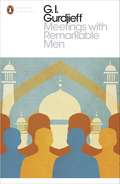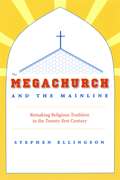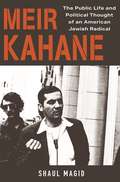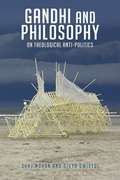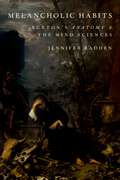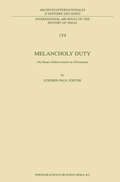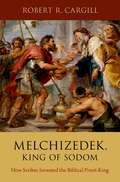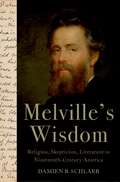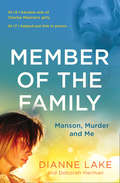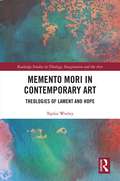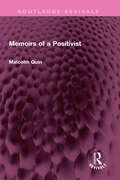- Table View
- List View
Meetings with Remarkable Men (Penguin Modern Classics)
by G. I. GurdjieffThe exhilarating, life-affirming call to spiritual arms from world-renowned spiritual teacher G. I. Gurdjieff'Gurdjieff's voice is heard as a call.He calls because he suffers from the inner chaos in which we live.He calls to us to open our eyes.He asks us why we are here, what we wish for, what forces we obey. He asks us, above all, if we understand what we are . . .'Part adventure narrative, part travelogue, part spiritual guide, Meetings with Remarkable Men is suffused with Gurdjieff's unique perspective on life. With vivacity and charm, he organizes his account around portraits of the remarkable men and women who accompanied him through remote parts of the Near East and Central Asia, and who aided his search for hidden knowledge. Among them are Gurdjieff's own father (a traditional bard), a Russian prince dedicated to the search for Truth, a Christian missionary who entered a World Brotherhood deep in Asia, and a woman who escaped slavery to become a trusted member of Gurdjieff's group of fellow seekers.Meetings with Remarkable Men conveys a haunting sense of what it means to live fully - with conscience, with purpose and with heart.
The Megachurch and the Mainline: Remaking Religious Tradition in the Twenty-first Century
by Stephen EllingsonReligious traditions provide the stories and rituals that define the core values of church members. Yet modern life in America can make those customs seem undesirable, even impractical. As a result, many congregations refashion church traditions so they may remain powerful and salient. How do these transformations occur? How do clergy and worshipers negotiate which aspects should be preserved or discarded? Focusing on the innovations of several mainline Protestant churches in the San Francisco Bay Area, Stephen Ellingson’s The Megachurch and the Mainline provides new understandings of the transformation of spiritual traditions. For Ellingson, these particular congregations typify a new type of Lutheranism—one which combines the evangelical approaches that are embodied in the growing legion of megachurches with American society’s emphasis on pragmatism and consumerism. Here Ellingson provides vivid descriptions of congregations as they sacrifice hymns in favor of rock music and scrap traditional white robes and stoles for Hawaiian shirts, while also making readers aware of the long history of similar attempts to Americanize the Lutheran tradition. This is an important examination of a religion in flux—one that speaks to the growing popularity of evangelicalism in America.
The Megachurch and the Mainline: Remaking Religious Tradition in the Twenty-first Century
by Stephen EllingsonReligious traditions provide the stories and rituals that define the core values of church members. Yet modern life in America can make those customs seem undesirable, even impractical. As a result, many congregations refashion church traditions so they may remain powerful and salient. How do these transformations occur? How do clergy and worshipers negotiate which aspects should be preserved or discarded? Focusing on the innovations of several mainline Protestant churches in the San Francisco Bay Area, Stephen Ellingson’s The Megachurch and the Mainline provides new understandings of the transformation of spiritual traditions. For Ellingson, these particular congregations typify a new type of Lutheranism—one which combines the evangelical approaches that are embodied in the growing legion of megachurches with American society’s emphasis on pragmatism and consumerism. Here Ellingson provides vivid descriptions of congregations as they sacrifice hymns in favor of rock music and scrap traditional white robes and stoles for Hawaiian shirts, while also making readers aware of the long history of similar attempts to Americanize the Lutheran tradition. This is an important examination of a religion in flux—one that speaks to the growing popularity of evangelicalism in America.
The Megachurch and the Mainline: Remaking Religious Tradition in the Twenty-first Century
by Stephen EllingsonReligious traditions provide the stories and rituals that define the core values of church members. Yet modern life in America can make those customs seem undesirable, even impractical. As a result, many congregations refashion church traditions so they may remain powerful and salient. How do these transformations occur? How do clergy and worshipers negotiate which aspects should be preserved or discarded? Focusing on the innovations of several mainline Protestant churches in the San Francisco Bay Area, Stephen Ellingson’s The Megachurch and the Mainline provides new understandings of the transformation of spiritual traditions. For Ellingson, these particular congregations typify a new type of Lutheranism—one which combines the evangelical approaches that are embodied in the growing legion of megachurches with American society’s emphasis on pragmatism and consumerism. Here Ellingson provides vivid descriptions of congregations as they sacrifice hymns in favor of rock music and scrap traditional white robes and stoles for Hawaiian shirts, while also making readers aware of the long history of similar attempts to Americanize the Lutheran tradition. This is an important examination of a religion in flux—one that speaks to the growing popularity of evangelicalism in America.
Mehrdeutige Körper: Über die Anerkennung intergeschlechtlicher Menschen in Theologie und Kirche (Religionswissenschaft #35)
by Katharina Mairinger-ImmischIntergeschlechtlichkeit bekommt verstärkt mediale Aufmerksamkeit - nicht aber in der katholischen Kirche und Theologie. Ausgehend von den religionssoziologischen Beobachtungen Pierre Bourdieus als auch von der freiheitstheologischen Anthropologie Thomas Pröppers wirft Katharina Mairinger-Immisch einen kritischen Blick auf die katholische Geschlechteranthropologie. Sie entwickelt dabei eine geschlechterinklusive Ethik, die die Haltung der Ambiguitätstoleranz fordert und fördert: eine Handlungsorientierung für die Anerkennung intergeschlechtlicher Menschen.
Meir Kahane: The Public Life and Political Thought of an American Jewish Radical
by Shaul MagidThe life and politics of an American Jewish activist who preached radical and violent means to Jewish survivalMeir Kahane came of age amid the radical politics of the counterculture, becoming a militant voice of protest against Jewish liberalism. Kahane founded the Jewish Defense League in 1968, declaring that Jews must protect themselves by any means necessary. He immigrated to Israel in 1971, where he founded KACH, an ultranationalist and racist political party. He would die by assassination in 1990. Shaul Magid provides an in-depth look at this controversial figure, showing how the postwar American experience shaped his life and political thought.Magid sheds new light on Kahane’s radical political views, his critique of liberalism, and his use of the “grammar of race” as a tool to promote Jewish pride. He discusses Kahane’s theory of violence as a mechanism to assure Jewish safety, and traces how his Zionism evolved from a fervent support of Israel to a belief that the Zionist project had failed. Magid examines how tradition and classical Jewish texts profoundly influenced Kahane’s thought later in life, and argues that Kahane’s enduring legacy lies not in his Israeli career but in the challenge he posed to the liberalism and assimilatory project of the postwar American Jewish establishment.This incisive book shows how Kahane was a quintessentially American figure, one who adopted the radicalism of the militant Left as a tenet of Jewish survival.
Meister Eckhart: Master of Mystics
by Richard WoodsTimothy Radcliffe introduces this masterly short guide to Eckhart's mystical teaching - perfectly pitched for those interested in spirituality and theology. Richard Woods writes as a passionate advocate of Eckhart's relevance to issues and challenges facing intelligent people today with emphasis on religious understanding, belief, action and human suffering. The fruit of more than ten years of reflection, Meister Eckhart: Master of Mystics explores a set of related themes bridging Eckhart's medieval world and our own turbulent times - women's role in spirituality and church life, global climate change and the sacredness of Creation, the meaning of detachment, the blind alleys of spiritual 'technology', the meaning of contemplation and the place of prayer, Eckhart's views on art and spirituality, his daring insights into the challenges of pain and suffering, and Eckhart's relevance for wider and deeper encounter among world religions. Other chapters investigate Eckhart's wide-ranging sources and his revolutionary approach to the redeeming mission of Jesus Christ.
Meister Eckhart and the Beguine Mystics: Hadewijch of Brabant, Mechthild of Magdeburg, and Marguerite Porete
by Bernard McGinnThe great German mystic Meister Eckhart remains one of the most fascinating figures in Western thought. Revived interest in Eckhart's mysticism has been matched, and even surpassed, by the study of the women mystics of the late13th century. This book argues that Eckhart's thought cannot be fully be understood until it is viewed against the background of the breakthroughs made by the women mystics who preceded him.
Melancholic Freedom: Agency and the Spirit of Politics (AAR Reflection and Theory in the Study of Religion)
by David Kyuman KimWhy does agency -- the capacity to make choices and to act in the world -- matter to us? Why is it meaningful that our intentions have effects in the world, that they reflect our sense of identity, that they embody what we value? What kinds of motivations are available for political agency and judgment in an age that lacks the enthusiasm associated with the great emancipatory movements for civil rights and gender equality? What are the conditions for the possibility of being an effective agent when the meaning of democracy has become less transparent? David Kyuman Kim addresses these crucial questions by uncovering the political, moral, philosophical, and religious dimensions of human agency. Kim treats agency as a form of religious experience that reflects implicit and explicit notions of the good. Of particular concern are the moral, political, and religious motivations that underpin an understanding of agency as meaningful action. Through a critical engagement with the work of theorists such as Judith Butler, Charles Taylor, and Stanley Cavell, Kim argues that late modern and postmodern agency is found most effectively at work in what he calls "projects of regenerating agency" or critical and strategic responses to loss. Agency as melancholic freedom begins and endures, Kim maintains, through the moral and psychic losses associated with a broad range of experiences, including the moral identities shaped by secularized modernity and the multifold forms of alienation experienced by those who suffer the indignities of racial, gender, class, and sexuality discrimination and oppression. Kim calls for renewing the sense of urgency in our political and moral engagements by seeing agency as a vocation, where the aspiration for self-transformation and the human need for hope are fundamental concerns.
Melancholic Habits: Burton's Anatomy & the Mind Sciences
by Jennifer RaddenJennifer Radden here provides a re-interpretation of the classic text by 17th century scholar Robert Burton, The Anatomy of Melancholy. Her new reading of Burton's essential text brings several key facets of his thought to light: the role of imagination in inciting and averting melancholy as disorder; the part played by daily habits of thought in engendering severe and incurable conditions; the multi-directional feedback loops linking feeling and thought in his model of mind; and an emphasis on symptoms and natural history in his understanding of disease. Much of Burton's account is derived from classical, medieval and renaissance writing about melancholy, yet he brought them together into something new: an account that -- while it stands in contrast to many of the assumptions of later psychology -- concurs surprisingly well with present day cognitivism. Moreover, although seventeenth century melancholy bears only a loose relationship to present day mood disorders such as depression and anxiety, on this reading the Anatomy anticipates a considerable number of findings and hypotheses associated with present day psychiatry, including its network models of depression, for example, and its emphasis on the part played by rumination and mind wandering in engendering affective disorder. Radden's new reading of a classic text should interest readers in philosophy of mind and psychiatry, clinical psychiatry and the history of medicine.
Melancholic Habits: Burton's Anatomy & the Mind Sciences
by Jennifer RaddenJennifer Radden here provides a re-interpretation of the classic text by 17th century scholar Robert Burton, The Anatomy of Melancholy. Her new reading of Burton's essential text brings several key facets of his thought to light: the role of imagination in inciting and averting melancholy as disorder; the part played by daily habits of thought in engendering severe and incurable conditions; the multi-directional feedback loops linking feeling and thought in his model of mind; and an emphasis on symptoms and natural history in his understanding of disease. Much of Burton's account is derived from classical, medieval and renaissance writing about melancholy, yet he brought them together into something new: an account that -- while it stands in contrast to many of the assumptions of later psychology -- concurs surprisingly well with present day cognitivism. Moreover, although seventeenth century melancholy bears only a loose relationship to present day mood disorders such as depression and anxiety, on this reading the Anatomy anticipates a considerable number of findings and hypotheses associated with present day psychiatry, including its network models of depression, for example, and its emphasis on the part played by rumination and mind wandering in engendering affective disorder. Radden's new reading of a classic text should interest readers in philosophy of mind and psychiatry, clinical psychiatry and the history of medicine.
Melancholy Duty: The Hume-Gibbon Attack on Christianity (International Archives of the History of Ideas Archives internationales d'histoire des idées #154)
by S.P. FosterThis book studies the complementary features of the thought of David Hume and Edward Gibbon in the complete range of its confrontation with eighteenth-century Christianity. The ten chapters explore the iconoclasm of these two philosophical historians - Hume as the premier philosopher, Gibbon as the consummate historian - as they labored to `naturalize' the study of Christianity, particularly with attention to its social and political dimensions. No other work deals as comprehensively or thoroughly with the attempt of philosophical history's challenge to Christianity. Belief in miracles and the afterlife, the dimensions of fanaticism and superstition, and the nature of religious persecution were the themes that occupied Hume and Gibbon in the making of their critique of Christianity. This book makes a valuable contribution to scholarship in a number of fields including the history of ideas, religious studies, and philosophy. It will be of interest to philosophers of religion, historians of ideas, eighteenth-century intellectual historians, scholars of the Scottish Enlightenment, and Hume and Gibbon scholars.
Melania the Younger: From Rome to Jerusalem (Women in Antiquity)
by Elizabeth A. ClarkMelania the Younger: From Rome to Jerusalem explores the richly detailed story of Melania, an early fifth-century Roman Christian aristocrat who renounced her staggering wealth to lead a life of ascetic renunciation. Hers is a tale of "riches to rags." Born to high Roman aristocracy in the late fourth century, Melania encountered numerous difficulties posed by family members, Roman officials, and historical circumstances in disposing of her wealth, property (spread across at least eight Roman provinces), and thousands of slaves. Leaving Rome with her entourage a few years before Alaric the Goth's sack of Rome in 410, she journeyed to Sicily, then to North Africa, finally settling in Jerusalem-all while founding monasteries along the way. Towards the end of her life, she traveled to Constantinople (present-day Istanbul) in an attempt to convert to Christianity her still-pagan uncle, who was on a state mission to the eastern Roman court. Throughout her life, she was accustomed to meet and be assisted by emperors and empresses, bishops, and other high dignitaries. Embracing a fairly extreme asceticism, Melania died in Jerusalem in 439. A new English translation of her Life, composed by a long-time assistant who succeeded her in the direction of the male and female monasteries in Jerusalem, accompanies this biographical study.
Melania the Younger: From Rome to Jerusalem (Women in Antiquity)
by Elizabeth A. ClarkMelania the Younger: From Rome to Jerusalem explores the richly detailed story of Melania, an early fifth-century Roman Christian aristocrat who renounced her staggering wealth to lead a life of ascetic renunciation. Hers is a tale of "riches to rags." Born to high Roman aristocracy in the late fourth century, Melania encountered numerous difficulties posed by family members, Roman officials, and historical circumstances in disposing of her wealth, property (spread across at least eight Roman provinces), and thousands of slaves. Leaving Rome with her entourage a few years before Alaric the Goth's sack of Rome in 410, she journeyed to Sicily, then to North Africa, finally settling in Jerusalem-all while founding monasteries along the way. Towards the end of her life, she traveled to Constantinople (present-day Istanbul) in an attempt to convert to Christianity her still-pagan uncle, who was on a state mission to the eastern Roman court. Throughout her life, she was accustomed to meet and be assisted by emperors and empresses, bishops, and other high dignitaries. Embracing a fairly extreme asceticism, Melania died in Jerusalem in 439. A new English translation of her Life, composed by a long-time assistant who succeeded her in the direction of the male and female monasteries in Jerusalem, accompanies this biographical study.
Melchizedek, King of Sodom: How Scribes Invented the Biblical Priest-King
by Robert R. CargillThe biblical figure Melchizedek appears just twice in the Hebrew Bible, and once more in the Christian New Testament. Cited as both the king of Shalem-understood by most scholars to be Jerusalem-and as an eternal priest without ancestry, Melchizedek's appearances become textual justification for tithing to the Levitical priests in Jerusalem and for the priesthood of Jesus Christ himself. But what if the text was manipulated? Robert R. Cargill explores the Hebrew and Greek texts concerning Melchizedek's encounter with Abraham in Genesis as a basis to unravel the biblical mystery of this character's origins. The textual evidence that Cargill presents shows that Melchizedek was originally known as the king of Sodom and that the later traditions about Sodom forced biblical scribes to invent a new location, Shalem, for Melchizedek's priesthood and reign. Cargill also identifies minor, strategic changes to the Hebrew Bible and the Samaritan Pentateuch that demonstrate an evolving, polemical, sectarian discourse between Jews and Samaritans competing for the superiority of their respective temples and holy mountains. The resulting literary evidence was used as the ideological motivation for identifying Shalem with Jerusalem in the Second Temple Jewish tradition. A brief study with far-reaching implications, Melchizedek, King of Sodom reopens discussion of not only this unusual character, but also the origins of both the priesthood of Christ and the role of early Israelite priest-kings.
Melchizedek, King of Sodom: How Scribes Invented the Biblical Priest-King
by Robert R. CargillThe biblical figure Melchizedek appears just twice in the Hebrew Bible, and once more in the Christian New Testament. Cited as both the king of Shalem-understood by most scholars to be Jerusalem-and as an eternal priest without ancestry, Melchizedek's appearances become textual justification for tithing to the Levitical priests in Jerusalem and for the priesthood of Jesus Christ himself. But what if the text was manipulated? Robert R. Cargill explores the Hebrew and Greek texts concerning Melchizedek's encounter with Abraham in Genesis as a basis to unravel the biblical mystery of this character's origins. The textual evidence that Cargill presents shows that Melchizedek was originally known as the king of Sodom and that the later traditions about Sodom forced biblical scribes to invent a new location, Shalem, for Melchizedek's priesthood and reign. Cargill also identifies minor, strategic changes to the Hebrew Bible and the Samaritan Pentateuch that demonstrate an evolving, polemical, sectarian discourse between Jews and Samaritans competing for the superiority of their respective temples and holy mountains. The resulting literary evidence was used as the ideological motivation for identifying Shalem with Jerusalem in the Second Temple Jewish tradition. A brief study with far-reaching implications, Melchizedek, King of Sodom reopens discussion of not only this unusual character, but also the origins of both the priesthood of Christ and the role of early Israelite priest-kings.
Melville's Wisdom: Religion, Skepticism, and Literature in Nineteenth-Century America (AAR Academy Series)
by Damien B. SchlarbIn Melville's Wisdom: Religion, Skepticism, Literature in Nineteenth-Century America, Damien B. Schlarb explores the manner in which Herman Melville responds to the spiritual crisis of modernity by using the language of the biblical Old Testament wisdom books to moderate contemporary discourses on religion, skepticism, and literature. Schlarb argues that attending to Melville's engagement with the wisdom books (Job, Proverbs, and Ecclesiastes) can help us understand a paradox at the heart of American modernity: the simultaneous displacement and affirmation of biblical language and religious culture. In wisdom, which addresses questions of theology, radical skepticism, and the nature of evil, Melville finds an ethos of critical inquiry that allows him to embrace modern analytical techniques, such as higher biblical criticism. In the medium of literature, he articulates a new way of accessing the Bible by marrying the moral and spiritual didacticism of its language with the intellectual distance afforded by critical reflection, a hallmark of modern intellectual style. Melville's Wisdom joins other works of post secular literary studies in challenging its own discipline's constitutive secularization narrative by rethinking modern, putatively secular cultural formations in terms of their reciprocity with religious concepts and texts. Schlarb foregrounds Melville's sustained, career-spanning concern with biblical wisdom, its formal properties, and its knowledge-creating potential. By excavating this project from his oeuvre, Melville's Wisdom shows how Melville celebrates intellectually rigorous, critical inquisitiveness, an attitude that we often associate with modernity but which Melville saw augured by the wisdom books. He finds in this attitude the means for avoiding the spiritually corrosive effects of skepticism.
Melville's Wisdom: Religion, Skepticism, and Literature in Nineteenth-Century America (AAR Academy Series)
by Damien B. SchlarbIn Melville's Wisdom: Religion, Skepticism, Literature in Nineteenth-Century America, Damien B. Schlarb explores the manner in which Herman Melville responds to the spiritual crisis of modernity by using the language of the biblical Old Testament wisdom books to moderate contemporary discourses on religion, skepticism, and literature. Schlarb argues that attending to Melville's engagement with the wisdom books (Job, Proverbs, and Ecclesiastes) can help us understand a paradox at the heart of American modernity: the simultaneous displacement and affirmation of biblical language and religious culture. In wisdom, which addresses questions of theology, radical skepticism, and the nature of evil, Melville finds an ethos of critical inquiry that allows him to embrace modern analytical techniques, such as higher biblical criticism. In the medium of literature, he articulates a new way of accessing the Bible by marrying the moral and spiritual didacticism of its language with the intellectual distance afforded by critical reflection, a hallmark of modern intellectual style. Melville's Wisdom joins other works of post secular literary studies in challenging its own discipline's constitutive secularization narrative by rethinking modern, putatively secular cultural formations in terms of their reciprocity with religious concepts and texts. Schlarb foregrounds Melville's sustained, career-spanning concern with biblical wisdom, its formal properties, and its knowledge-creating potential. By excavating this project from his oeuvre, Melville's Wisdom shows how Melville celebrates intellectually rigorous, critical inquisitiveness, an attitude that we often associate with modernity but which Melville saw augured by the wisdom books. He finds in this attitude the means for avoiding the spiritually corrosive effects of skepticism.
Member of the Family: Manson, Murder And Me
by Dianne LakeFollowing the recent death of Charles Manson – the leader of the sinister 60s cult – Dianne Lake reveals the true story of life with Manson and his ‘family’, who became notorious for a series of shocking murders during the summer of 1969.
Memento Mori in Contemporary Art: Theologies of Lament and Hope (Routledge Studies in Theology, Imagination and the Arts)
by Taylor WorleyThis book explores how four contemporary artists—Francis Bacon, Joseph Beuys, Robert Gober, and Damien Hirst—pursue the question of death through their fraught appropriations of Christian imagery. Each artist is shown to not only pose provocative theological questions, but also to question the abilities of theological speech to adequately address current attitudes to death. When set within a broader theological context around the thought of death, Bacon’s works invite fresh readings of the New Testament’s narration of the betrayal of Christ, and Beuys’ works can be appreciated for the ways they evoke Resurrection to envision possible futures for Germany in the aftermath of war. Gober’s immaculate sculptures and installations serve to create alternative religious environments, and these places are both evocative of his Roman Catholic upbringing and virtually haunted by the ghosts of his excommunication from that past. Lastly and perhaps most problematically, Hirst has built his brand as an artist from making jokes about death. By opening fresh arenas of dialogue and meaning-making in our society and culture today, the rich humanity of these artworks promises both renewed depths of meaning regarding our exit from this world as well as how we might live well within it for the time that we have. As such, it will be a vital resource for all scholars in Theology, the Visual Arts, Material Religion and Religious Studies.
Memento Mori in Contemporary Art: Theologies of Lament and Hope (Routledge Studies in Theology, Imagination and the Arts)
by Taylor WorleyThis book explores how four contemporary artists—Francis Bacon, Joseph Beuys, Robert Gober, and Damien Hirst—pursue the question of death through their fraught appropriations of Christian imagery. Each artist is shown to not only pose provocative theological questions, but also to question the abilities of theological speech to adequately address current attitudes to death. When set within a broader theological context around the thought of death, Bacon’s works invite fresh readings of the New Testament’s narration of the betrayal of Christ, and Beuys’ works can be appreciated for the ways they evoke Resurrection to envision possible futures for Germany in the aftermath of war. Gober’s immaculate sculptures and installations serve to create alternative religious environments, and these places are both evocative of his Roman Catholic upbringing and virtually haunted by the ghosts of his excommunication from that past. Lastly and perhaps most problematically, Hirst has built his brand as an artist from making jokes about death. By opening fresh arenas of dialogue and meaning-making in our society and culture today, the rich humanity of these artworks promises both renewed depths of meaning regarding our exit from this world as well as how we might live well within it for the time that we have. As such, it will be a vital resource for all scholars in Theology, the Visual Arts, Material Religion and Religious Studies.
Memoirs of a Mission: The Ismaili Scholar, Statesman and Poet, Al-Mu-ayyad Fi'l-Din Al-Shirazi (Ismaili Heritage)
by Verena KlemmAl-Mu'ayyad fi'l-DÌn al-ShÌrzÌ (d. 470/1087) was an outstanding, multi-talented Fatimid scholar of Persian origin. He excelled as a missionary-agent, statesman, poet, preacher and theologian. Based on his autobiography, this work provides an insight into the remarkable life and achievements of al- Mu'ayyad through important stages of his career, describing his daring attempt to win over the Buyids of western Iran to the Fatimid cause, his dangerous flight to Cairo and finally his expedition to Syria and Iraq to build up an alliance of local rulers against the invading Saljuk Turks. The author demonstrates that in addition to being a fascinating personal account, the life of al-Mu'ayyad is a rich source of Islamic history in the 5th/11th century dealing with crucial events in the struggle between the Fatimids, Abbasids, Buyids and Saljuks for supremacy in the Muslim world.
Memoirs of a Positivist (Routledge Revivals)
by Malcolm QuinFirst published in 1924, Memoirs of a Positivist is both an autobiography of the author and a history of the English Positivist movement in the nineteenth and twentieth centuries. It especially elaborates on the influence of the Positivist movement in the religious life of people and the manners in which scientific reasons were sought for religious beliefs. This book will be of interest to students of philosophy, religion and history.
Memoirs of a Positivist (Routledge Revivals)
by Malcolm QuinFirst published in 1924, Memoirs of a Positivist is both an autobiography of the author and a history of the English Positivist movement in the nineteenth and twentieth centuries. It especially elaborates on the influence of the Positivist movement in the religious life of people and the manners in which scientific reasons were sought for religious beliefs. This book will be of interest to students of philosophy, religion and history.
Memoirs of a Very Dangerous Man
by Donald Reeves'A Visionary with Attitude' Jack DeeThe most extraordinary clergyman in the Church of England' The Times'A very dangerous man' Baroness ThatcherDonald Reeves is a cult figure in religious and political circles. The former Rector of St James` Piccadilly, is a man of action and vision who lives out his religious belief through political activity and struggle. He is charismatic with enormous personal charm and persuasiveness.  After a conventional middle-class upbringing, Reeves felt pushed by God to be ordained. Following an apprenticeship at Maidstone, where he was already a controversial figure, Reeves became Chaplain to the notorious Anglican bishop Mervyn Stockwood. He was thus trained in an atmosphere of socialist politics with a tinge of sexual ambiguity. Stockwood is just one of the figures about whom Reeves writes with relish and acuity in this volume of memoirs. After being radicalized in Chicago in 1968 he carried the revolution to a housing estate in South London. Reeves' heyday was as Rector of St James`s Church in Piccadilly, a space he filled with extraordinary worship, celebrated pulpit dialogues, a coffee house, street market and through which there was an endless march of gurus, leading international film-makers, writers, theologians and politicians.  Reeves had several brushes with Margaret Thatcher. He has also been an adviser to Rio Tinto on corporate responsibility and worked for Mittal Steel in Bosnia. Today he devotes himself to working for peace in the Balkans, a region he argues which could so easily disintegrate into messy conflict again. Reeves never lets the grass grow under his feet. His energy is inexhaustible (even in his seventies) and this energy pulsates through the pages of this fascinating book.
